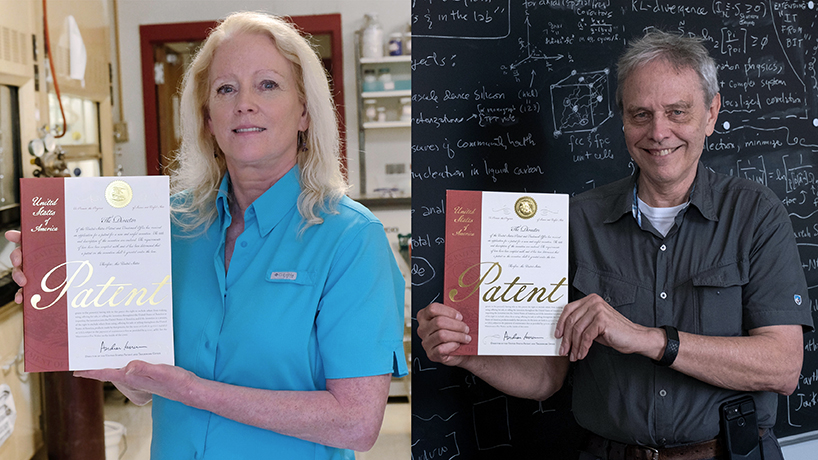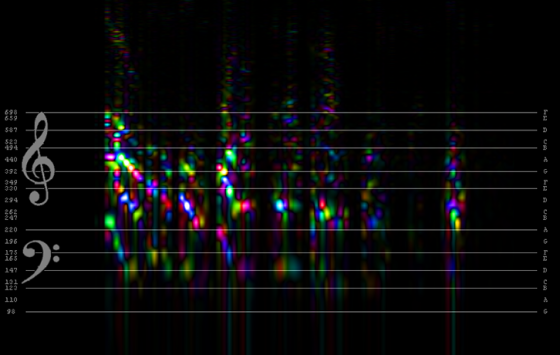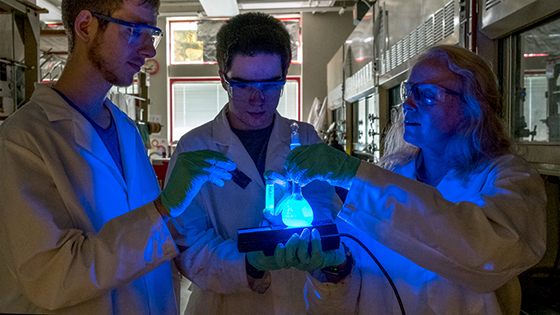
The United States Patent and Trademark Office granted (from left) Professor of Chemistry and Biochemistry Janet Wilking and Associate Professor of Physics Phillip Fraundorf patents in 2019 for work that spans efforts of at least 10 years. (Photos by August Jennewein)
Phillip Fraundorf enjoys imitating birds to get a conversational back and forth going. Curious as to his accuracy, he decided to compare his calls to a bird’s with an app that used technology he’d developed to depict all aspects of a sound wave.
Not even close.
“When I look at what my sound looks like on the phone compared to the birds’, I think they are just having sympathy for me,” the associate professor of physics said. “Like, ‘There’s a poor animal. It’s on its last leg.’”
This year, the United States Patent and Trademark Office gave Fraundorf’s visualizations – though not his bird calls – its stamp of approval by issuing his patent “Log complex color for visual pattern recognition of total sound.” That’s one of two University of Missouri–St. Louis patents issued in 2019: The other is Professor of Chemistry and Biochemistry Janet Wilking’s “Cyclic germanium compounds and applications thereof.”
As far as patents go, the University of Missouri System does well, ranking No. 60 on the National Academy of Inventors‘ “Top 100 Worldwide Universities Granted U.S. Utility Patents 2018.” Since 1971, UMSL faculty have submitted 173 invention disclosures and hold 54 issued U.S. utility patents, 48 of which have been issued since Fiscal Year 2000.
Fraundorf and Wilking will be inducted into to NAI at the spring 2020 Research and Innovation Reception.
Illustrating sound
To appreciate Fraundorf’s patent, you have to understand that, historically, scientists haven’t had a great way to depict sound.
Sound is vibration, which travels as a wave. The people that measure it do so in terms of frequency, how high or low a note is; amplitude, loudness; and phase, one up and down wave cycle. Looking at all those components together is fairly incomprehensible, so most visualizations break up the wave into its component parts.
This visualization example shows a speaker saying the theater exercise “woo, whoa, war, wow.” Fraundorf depicts phase as color and amplitude as brightness as well as the many tones that accompany each component – the harmonics – as a trail of color that extends beyond the base and treble clef. (Image courtesy of Fraundorf)
Fraundorf’s visualizations, on the other hand, include all of the above and go a step further by doing so on a generally understood form – sheet music.
The result is such a complete picture that one could reproduce the original sound from the visualization.
“Our approach to patenting was not to say, ‘Oh, it’s a cool idea’ or ‘It’s a new algorithm’ or any of that stuff but to basically take various technologies that are established and combine them in a new way,” Fraundorf said.
He united color and brightness to depict complex numbers with time-frequency spectrograms and sheet music.
Along with his co-investigators Stephen Wedekind and Wayne Garver, Fraundorf has been working since the early 2000s on components of this project, which included looking at sound in crystals under an electron microscope and doing real-time visualizations of the Ariana String Quartet in his “How Things Work” course.
Fraundorf is considering licensing his work. He sees there being potential for the hearing impaired and for artificial intelligence technologies, which mostly use time-frequency spectrograms to understand human speech, and for a visual database of sounds.
“If you hear any interesting sound snippets, record them and send them to us,” he said. “We’ll see what they look like and put that out there.”
Creating light
Wilking has been working for at least 10 years on synthesizing germoles – the luminescent five-atom molecules comprised of germanium and carbons that are the subject of her recently issued patent.
However, it would be fair to say she’s been building up to it since she was an undergraduate working in the silicon chemistry lab of Joyce Corey, UMSL professor emeritus of chemistry.
“I’ve always been fascinated with science,” Wilking said. “I found chemistry to be very interesting to me, and I liked to make molecules. I never dreamed that I’d end up being a faculty member here.”
Working with silicon, Wilking explained, is similar to germanium because they are in the same group on the periodic table of elements so they possess certain overlapping properties. Wilking saw an opportunity in germanium because most contemporaneous florescence research with heavier Group 14 elements is done with silicon compounds.
Janet Wilking demonstrates the fluorescent property of the germanium molecule she synthesized. The compounds can be used in OLEDs, known for lighting screens of electronic devices.
Wilking’s germoles are unique because they emit very strong blue luminesce in a solid state. That makes them well-suited for organic light-emitting diodes, which are used for screens in phones, televisions and other digital devices.
She started the process with the intention of creating something simple to build upon and then determined which groups enhanced the molecules’ emissive properties.
“We started with a carbon-containing molecule and a germanium-containing molecule, and we have to do some chemistry on the carbon part first to make it reactive,” Wilking said. “Then we react them together, and the carbon-germanium bonds form to give the new molecule. We have a small hand-held UV light that we can shine on the molecule to see if there is florescence. Then we can tell if it’s being formed.”
Wilking is collaborating with Professor Cynthia Dupureur’s lab to experiment with adding different groups onto the germole ring in order to make the molecules water soluble for biological applications.
The National Science Foundation and UM System FastTrack funding helped support the work that went into Wilking’s patent, and Tamara Wilgers, director of the Office of Technology Commercialization and Economic Development, shepherded it – and Fraundorf’s patent – into being.
“It’s exciting when you make a molecule that has an important and interesting application and class of molecules,” Wilking said. “It’s nice to see it go from making it in the laboratory to having the patent awarded.”
















